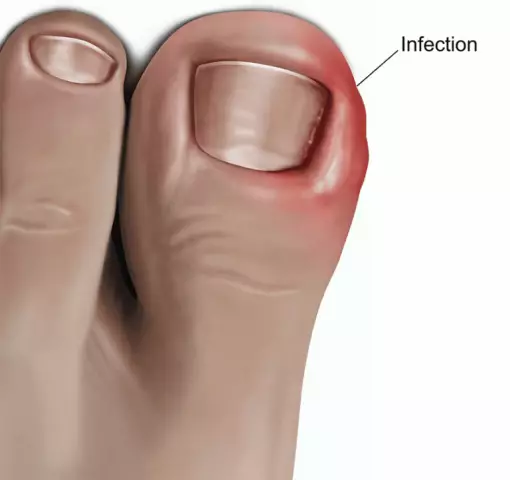- Author Rachel Wainwright [email protected].
- Public 2023-12-15 07:39.
- Last modified 2025-11-02 20:14.
Amorolfine
Amorolfin: instructions for use and reviews
- 1. Release form and composition
- 2. Pharmacological properties
- 3. Indications for use
- 4. Contraindications
- 5. Method of application and dosage
- 6. Side effects
- 7. Overdose
- 8. Special instructions
- 9. Application during pregnancy and lactation
- 10. Use in childhood
- 11. Drug interactions
- 12. Analogs
- 13. Terms and conditions of storage
- 14. Terms of dispensing from pharmacies
- 15. Reviews
- 16. Price in pharmacies
Latin name: Amorolfine
ATX code: D01AE16
Active ingredient: amorolfine (Amorolfine)
Producer: LLC "Tula Pharmaceutical Factory" (Russia)
Description and photo update: 2020-14-05

Amorolfine is an antifungal agent for external use.
Release form and composition
Produced in the form of medicinal nail varnish 5%: transparent colorless or light yellow liquid (in dark glass bottles of 0.5; 1; 1.5; 2; 2.5; 3; 3.5; 4; 4.5; 5; 6; 7; 8; 9 or 10 ml; in a cardboard box, instructions for the use of Amorolfine and 1 polypropylene container, which contains 1 bottle of varnish, 12 nail files in a plastic bag, 6 applicators with polypropylene spatulas, 12 sachets with cleansing tampons).
Composition of 1 ml of nail polish:
- active substance: amorolfine (in the form of hydrochloride) - 50 mg;
- auxiliary components: ethyl acetate; triacetin (glycerol triacetate); ethanol 95%; butyl acetate; copolymer of ammonium methacrylate, type A (copolymer of trimethylammonioethyl methacrylate chloride, methyl methacrylate and ethyl acrylate).
Pharmacological properties
Pharmacodynamics
The active ingredient of the drug is amorolfine, an antifungal agent with fungistatic and fungicidal action. The properties of the agent are due to its ability to disrupt the biosynthesis of sterols, which leads to damage to the cytoplasmic membrane of the fungus.
Amorolfine also reduces ergosterol levels, promotes the accumulation of atypical non-planar sterol stereoisomers.
The drug has a wide spectrum of action. It is especially active against the following pathogens:
- dermatophytes: Epidermophyton, Trichophyton, Microsporum;
- molds: Scopulariopsis, Alternaria, Hendersonula;
- yeast fungi: Candida, Cryptococcus, Malassezia, Pityrosporum;
- mushrooms from the Dematiaceae family: Fonsecaea, Cladosporium, Wangiella;
- dimorphic fungi: Histoplasma, Coccidioides, Sporothrix;
- actinomycetes.
Fusarium, Aspergillus, Mucorales are insensitive to amorolfine.
Pharmacokinetics
After applying the drug to the nails, amorolfine almost completely penetrates during the day, first into the nail plate, and then into the nail bed.
In the nails affected by the fungus, the effective concentration of the substance remains for 7-10 days after the first application.
Systemic absorption of the drug is insignificant. In plasma, the concentration is so low that it cannot be determined (less than 0.5 ng / ml, i.e., below the detection limit of detection methods).
Indications for use
Amorolfine is used for the prevention and treatment of fungal diseases on the nail plates caused by sensitive pathogens.
Contraindications
Absolute:
- age up to 18 years;
- pregnancy;
- lactation period;
- hypersensitivity to any component of the drug.
With caution, after consulting a doctor, Amorolfin varnish should be used in the following cases:
- structural change or destruction of the nail plate;
- chronic skin diseases (eg psoriasis);
- conditions predisposing to the development of fungal infections, such as diabetes mellitus, immunodeficiency diseases, impaired peripheral circulation.
Amorolfine, instructions for use: method and dosage
The drug is intended for external use. It should be applied 1-2 times a week.
Rules for using Amorolfine for nail fungus:
- With the help of nail scissors, cut off the maximum amount of the affected part of the nail. With the file included in the kit, carefully walk over the affected surfaces.
- Degrease and clean the nail surface with the supplied alcohol swab.
- Dip the applicator with a spatula into the varnish. When removing from the bottle, be careful not to touch the neck. Do not wipe off excess varnish on the neck of the bottle.
- With the same spatula, apply the drug to the entire surface of the affected nail plate.
- Repeat steps 1-4 for all affected nails.
- Close the bottle tightly. Wipe the spatula with a cleaning swab.
- Leave the varnish for 3-5 minutes to dry.
Before the next application of varnish, the previous layer must be removed with a cleaning swab. All other steps, including nail file and subsequent cleaning with a swab, should be repeated.
If you miss the next scheduled application, you must complete the procedure as soon as possible. Do not use an increased dose of the drug (apply several layers of varnish).
Treatment with Amorolfine is carried out until the affected part of the nail grows back and is replaced by healthy tissue. Typically, the treatment of nail plates on the hands is 6 months, on the legs - 9-12 months.
It is recommended to evaluate the effectiveness of the drug not earlier than after 3 months, since nails grow slowly. If after this period there is no improvement in the condition, worsening or new symptoms appear, you should consult a doctor.
Side effects
- local reactions: rarely (from ≥ 1/10 000 to <1/1000) - onychorexis (brittle nails), onychoclasia (brittle nails), discoloration and damage to nails; very rarely (<1/10 000) - burning sensation of the skin near the place of application of the drug;
- on the part of the skin and subcutaneous tissues: the frequency is unknown (on the basis of the available data it was not possible to establish the frequency of side effects) - urticaria, pruritus, blistering, contact dermatitis, erythema;
- from the immune system: the frequency is unknown - systemic allergic reactions due to increased sensitivity to the drug.
Overdose
With the correct use of Amorolfine for nail fungus and in recommended doses, the development of symptoms of an overdose is unlikely.
If you accidentally take the drug inside, you need to wash the stomach as soon as possible. If necessary, carry out symptomatic treatment.
special instructions
The included files are intended exclusively for cutting off nails affected by fungus. To avoid infection, it is strictly forbidden to use them on healthy nail plates.
Women during therapy should not use false artificial nails and use cosmetic varnish.
Care must be taken when applying the drug, avoiding contact with mucous membranes, eyes and ears.
Patients who work with organic solvents (kerosene, gasoline, etc.) should wear sealed protective gloves on their hands with varnished nails.
After each use of Amorolfine, it is important to close the bottle tightly to prevent the varnish from drying out. Cleansing swabs are impregnated with alcohol, which is flammable. Unused product must not be poured into water and household waste.
If allergic reactions develop, treatment should be stopped. A doctor's consultation is required.
The varnish contains ethanol as one of the auxiliary components. If used too often or improperly, there is a risk of dry skin and irritation around the nails.
Patients who have more than 2/3 of the nails destroyed or affected by the fungus are advised to consult a doctor so that he prescribes simultaneous oral antifungal therapy.
Influence on the ability to drive vehicles and complex mechanisms
Given the external use of Amorolfin varnish, its negative effect on cognitive and psychomotor functions of a person is unlikely.
Application during pregnancy and lactation
Amorolfine is contraindicated in pregnant women and women who are breastfeeding.
Pediatric use
Amorolfine is not used to treat patients under the age of 18 years.
Drug interactions
The interaction of Amorolfine with other drugs / agents has not been studied.
Analogs
Amorolfin's analogs are Atifin, Batrafen, Bifosin, Candibene, Candide, Kanizon, Lotseril, Lamisil, Lamitel, Mikoderil, Mikospor, Naftoderil, Oflomil LAK, Onichelp, Sertamicol, Terbifin, Fungosept, Cyclopoli, Ekodaxodax.
Terms and conditions of storage
Store in a dark place, out of the reach of children, at a temperature not exceeding 25 ° C.
Shelf life is 2 years.
Terms of dispensing from pharmacies
Available without a prescription.
Reviews about Amorolfine
Reviews of Amorolfine are ambiguous. On a 5-point scale, his average score is 2.83 points. Most patients indicate insufficient effectiveness of the drug, however, they carried out self-treatment, without consulting a doctor. The instructions clearly state that in the presence of significant damage to the nail plate (2/3 or more), simultaneous administration of oral antifungal agents is required to cure. Perhaps for this reason, the therapy was left without the desired result. Also, many note the long duration of treatment, only now it is due to the speed of nail regrowth, and not the properties of the drug.
At the same time, some patients write that Amorolfine is an effective remedy in the fight against fungus. At the same time, the majority of users consider the cost of this drug to be overestimated, since there are many products with a similar effect, but at a lower price.
As for the varnish itself, it is actually a viscous thick solution. Dries quickly. Many people are unhappy with the bottle neck being too narrow, which makes it difficult to reach the applicator without hitting the neck.
The price of Amorolfine in pharmacies
The price of Amorolfine in the form of medicinal nail varnish, depending on the pharmacy network, can range from 745 to 1109 rubles. per bottle of 2.5 ml.

Anna Kozlova Medical journalist About the author
Education: Rostov State Medical University, specialty "General Medicine".
Information about the drug is generalized, provided for informational purposes only and does not replace the official instructions. Self-medication is hazardous to health!






